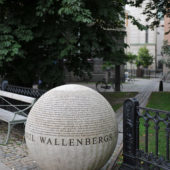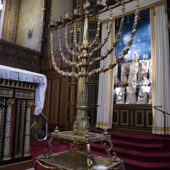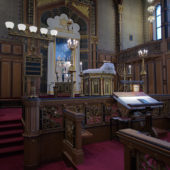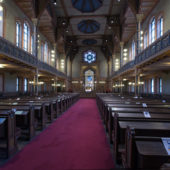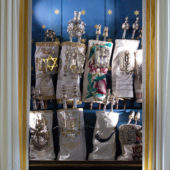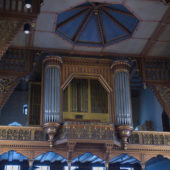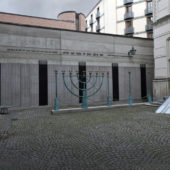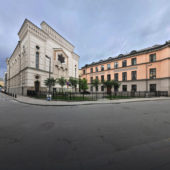One of Sweden’s official national historical buildings, The Great Synagogue was built in a oriental – byzantine style with a pipe organ. Women are counted in the minyan.
Jews were not allowed to live legally in Sweden until the 1770s; prior to that time they lived and practiced their religion in secret. It is recorded that Samson Efraim and his son visited Goteborg and Stockholm on business in 1702. Jewish businessmen increasingly came to Sweden in subsequent years, due to the demands of the East Indian Trading Company. In 1733 Jews were allowed to attend auctions in Goteborg and a small Jewish community of eight people lived in Stockholm until 1734.
Aron Isak, a German seal engraver, was the first Jewish person to receive permission to live in Sweden. He was first offered citizenship if he would become a Christian, to which he replied, “I would not change my religion for all the gold in the world.” This impressed the Lord Mayor of Stockholm, who convinced King Gustav III to grant him citizenship as the first Swedish Jew. He was allowed to bring Jewish families with him so that there would be at least ten Jewish men to hold a minyan (religious/prayer service). By 1775, foreigners (including Jews) were allowed to live on the island of Marstrand, just off the coast of Goteborg. In 1780 the first Jew settled in Goteborg and in 1782, legislation was passed permitting Jews to settle in the cities of Stockholm, Goteborg, Norrkoping, Karlskorna and Marstrand (the latter only from 1775-1794), without converting to Christianity.
In 1776 the first Jewish cemetery in Sweden was established. Seven years later Jews were allowed to build synagogues, perform services and engage in businesses and crafts that were not subject to guilds. In 1838 King Charles XIV began to remove some of the restrictions placed on Jews, allowing them increased civil rights and legal protection. By 1870, the Jewish emancipation increased yet it was not until 1951 that Jews could hold a public office. The Jewish population increased from 900 in 1840 to about 6,500 by 1920. Immigration was regulated following WWI. Fear of a large-scale Jewish immigration led to student demonstrations at Uppsala and Lund Universities in 1938. From 1933 to 1939 only 3,000 Jews were allowed to immigrate to Sweden and an additional 1,000 were allowed to travel through Sweden on to another country.
Once the intent of the Nazi regime became clear, Sweden opened her doors to immigration and was involved in trying to save Jews from the Holocaust, although it was a “neutral” country. In 1942 Sweden permitted 900 Norwegian Jews to immigrate into the country and in October of 1943 gave asylum to over 8,000 Danish Jews who escaped in small fishing boats, as well as the thousands of Hungarian Jews saved by Swedish diplomat Raoul Wallenberg. Count Folke Bernadotte helped bring both Jews and non-Jews out of concentration camps. Sweden also accepted refugees from the Baltic Republic, Lithuania and Estonia. Post WWII, many Holocaust survivors were brought to Sweden for rehabilitation. In 1956 Sweden accepted hundreds of Hungarian Jews fleeing the communist regime and in 1968, accepted thousands more from the communist-led witch-hunts. Jews from Czechoslovakia and Poland immigrated to Sweden, many of whom were intellectuals, university students and young professionals. Between 1945 and 1970 the Jewish population in Sweden doubled. In 2010 the Jewish population of Sweden is approximately 18,000, with the largest community of over 5,500 living in Stockholm.
The earliest Reform congregants began meeting in the Old town in 1787. They moved to another location from 1790 through 1870. Designs for The Great Synagogue were drawn up by architect, Fredrik Wilhelm Scholander in 1862. Construction began in 1867 on the small street of Wahrendorffsgatan, which was near a park on Norrmalm in Stockholm. Completed in 1870, the Synagogue is listed in the Swedish registry of national historical buildings. Between the first and second World Wars, Jews arrived from Eastern Europe and the Great Synagogue began practicing Orthodox Judaism, as did the newer shuls in Stockholm, Adas Jeschurun, Adat Jisrael and Baruch Hashem. The community of Jews in the city is considered to be very liberal and the number of religious Jews comparatively is small.
The 900 seat building has been called a “paraphrase over Oriental motifs” (Nordisk familjebok 26, col. 1470). The oriental styling of this and other synagogues (including the Moorish styling also popular at the time), was intended to evoke the past of the Jewish people in the land of Israel and in Medieval Spain, while the size and location of the synagogues in the city centers indicated the newly acquired legal status and social respectability of the Jewish community. At present, the Synagogue is affiliated with the Conservative movement, not Reform. Men and women sit together on the right side of the ground floor, men only sit on the left side of the ground floor, and women only sit in the upstairs women’s gallery.
The façade is attractively appointed with decorative moldings and deep cornicing just below the roofline. Five high lancet windows are situated in the central section above the entrance, of the brick façade. The Hebrew inscription between the cornice is inscribed in Hebrew, “And let them make Me a sanctuary; that I may dwell among them” (Ex. 25:8). The five windows on the western façade are replaced by a rose window, symbolic of a Star-of-David. The prayer room is spectacular, with gold walls and magnificently carved and painted woodwork. The ceiling features octagonal cupolas and beautiful lancet windows adorning the side walls. The bimah is on a slightly raised platform along the eastern wall, dominated by the magnificent rose design stained-glass window. Below the window is the Byzantine-styled Aron Kodesh. Carved of wood, it is gilding above and inscribed in Hebrew, white below with a gold Star-of-David, with a white Torah curtain drawn open, revealing beautifully encased Torah scrolls. A wood tivah (reader’s desk) with gold detailing sits on the podium in front of the Aron Kodesh. Gold, lit menorahs are situated on either side of the tivah. An intricately carved wood balustrade runs across the front of the bimah, with openings at both sides. The women’s gallery is upstairs, running along the sides and back of the prayer room. Similarly beautiful, intricately carved wood paneling separates the gallery from the main sanctuary. Similarly intricate columns that support the gallery run from the ceiling to the ground floor. Behind the women’s gallery in the back of the prayer room is the magnificent pipe organ. There is a blue cupola with brown beams in the cupola just in front of the pipe organ, painted to tie-in with brown woodwork with blue highlights. Elegant wood pews fill the sanctuary.
The Jewish Community Library, under the guidance of Lars Raij, is located below the Synagogue. Its multilingual collection of books comprises editions in Swedish, English, German, French, Hebrew and other languages. It includes the library of the former Chief Rabbi of Sweden, Rabbi Marcus Ehrenpreis (1869-1951). The library also hosts occasional exhibits, including the 2007 exhibit of the Freidrich Kellner WWII diary, which chronicles the years of the Third Reich and the Holocaust of European Jewry. The Great Synagogue has served as the focal point for all Jewry in Stockholm and in fact, Sweden.


